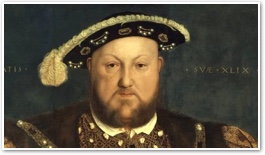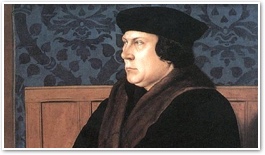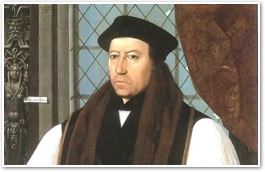Never forget the bloody horrors of the English Reformation
- DOMINIC SELWOOD
Amid celebrations of the Reformation's 500th anniversary, we should remember the mass persecutions of 16th century England.
 Henry VIII
Henry VIII1491-1491
Martin Luther was a theologian. If you read the Ninety-Five Theses he reputedly tacked up on the door of Wittenberg's Schlosskirche in October 1517, it is clear his interest lay in the nature of sin, repentance, absolution, penance and salvation. Whatever else his wider agenda was — or became — his initial arguments were presented as scriptural debate on the revealed path to salvation.
The English Reformation, on the other hand, had no basis in theological debate. King Henry VIII despised Luther and all he stood for. Henry's robust defence of the seven sacraments in the Assertio septem sacramentorum of 1521 was the first royal refutation of Luther's ideas, and it did not pull its punches, using phrases like "filthy villain" and "deadly venom". In recognition of its vigour, Pope Leo X granted Henry the title "Defender of the Faith", and the book went through multiple reprints.
A decade later, Henry's mind had moved on from the sacraments, and was preoccupied with the politics of the bedchamber and his dynasty. When Pope Clement VII refused to annul Henry's marriage to Katherine of Aragon, Henry concluded that the most effective solution would be to sideline the Holy See.
Once settled on the plan, it all got going in 1533.
In January, Henry bigamously married Anne Boleyn, his pregnant mistress. In March, on Passion Sunday, the relatively unknown Protestant-leaning Thomas Cranmer was consecrated 69th Archbishop of Canterbury. In April, Parliament passed the Act in Restraint of Appeals, cutting off all legal recourse to Rome. And in May, Cranmer pronounced the long-desired annulment of Henry's marriage to Katherine, then presided over Anne's coronation.
Henry now had what he wanted. But his new wife had come at a high cost. He had changed the country's religion to get her, and now he had to implement the new faith nationwide.
 Thomas Cromwell
Thomas Cromwell1485-1540
What Henry needed were loyal lawyers and theologians to reshape the religion.
In Thomas Cromwell, he found the former. And in Cranmer the latter. Cromwell began enriching himself by pillaging and razing the monasteries. Cranmer legitimised Henry's every move spiritually.
Henry was secure in the knowledge he had ambitious fixers around him, but what about the response of the rest of the country? It quickly became apparent that despite passing the Act of Supremacy in 1534 making himself head of the English Church (Ecclesia Anglicana), legislation alone was not going to be sufficient to ensure the cooperation of the English people. Nor were Cranmer's sermons and those of the other new bishops.
With little alternative, Henry resorted to the most basic tool of his power: violence.
Burning people for heresy was an option, but it would raise a few eyebrows. The problem was that Henry largely believed in the same traditional theology that his people did. He had not changed his views from the time of writing the Assertio. This ruled out widespread heresy trials. The solution his circle came up with was more radical.
Treason was originally a common law offence, but put on to a statutory basis by King Edward III in the Treason Act 1351. (It is still in force, although heavily modified, and last used in 1945 against William Joyce, "Lord Haw-Haw".)
The punishment for high treason was hanging, drawing, and quartering — first recorded in 1238 for an "educated man-at-arms" (armiger literatus) who tried to assassinate King Henry III. Other famous early victims included Dafydd ap Gruffydd in 1283 and William Wallace in 1305. The victim was drawn (dragged) to the place of execution on a hurdle or sledge. There he was hanged (slowly strangled), and while alive his genitals were cut off, his abdomen was sliced open, his bowels were pulled out, and they were burned in front of him. Once dead, he was cut down, beheaded, sliced into quarters, and a section sent to each of the four corners of the kingdom for public display. For a woman, the punishment was burning and quartering.
 Thomas Cranmer
Thomas Cranmer1489-1556
Henry's first victim was a 28-year-old nun, Elizabeth Barton. She had visions which earned her a following among leading clergymen, and she had even enjoyed an audience with Henry. However, when her prophecies spoke of the wrong Henry was doing by abandoning Katherine and marrying Anne, she crossed a line. Her visions, in fact, suited Cranmer, as condemning her gave him the chance to damage some of her theologically conservative clergy supporters. He and Cromwell obtained her confession to having faked trances, to heresy, and to treason. On April 20, 1534 she was hanged and beheaded at Tyburn along with five of her supporters (two monks, two friars, and a secular priest). Her head was then spiked on London Bridge, making her the only woman in English history to suffer this fate.
As the new religion was promulgated from London, there was deep resentment in the countryside. Particular objection was taken to Cranmer's "Ten Articles" of 1536 (the new church's canon of beliefs), to Cromwell's ransacking of the monasteries, and to his attempts to increase his personal power in the north.
On October 1, 1536, people gathered at Louth in Lincolnshire. Others joined and, before they knew it, thousands had occupied Lincoln demanding an end to the changes. Henry countered with threats of military reprisals, and the uprising melted away.
In the aftermath, Nicholas Melton ("Captain Cobbler"), the vicar of St James's in Louth where the uprising began, and its other leading figures, were duly hanged, drawn and quartered.
Further north, 40,000 people from Yorkshire, Durham, Northumberland, and Lancashire took York, demanding a return to the old ways. This was the famous "Pilgrimage of Grace". After securing the surrender of 300 men guarding the royal castle at Pontefract, the pilgrims were led by royal representatives to believe their requests had been met. They stood down, and then the reprisals began. Some 220 to 250 were executed, including the leaders: Robert Aske and Baron Darcy of Templehurst, as well as Sir Francis Bigod, who led a simultaneous uprising in Cumberland and Westmorland.
Wriothesley's Chronicle confirmed that hanging, drawing, and quartering was performed in more or less the traditional way at this time. One terse description reads that the victim was, "hanged, membred, bowelled, headed, and quartered".
One of the most shocking executions was that of Margaret Pole, the 67-year-old Countess of Salisbury, who was beheaded without trial in 1541 because Henry was furious with her son, Cardinal Reginald Pole, who had slipped abroad.
Not all were executed for treason. A limited number of heresy trials were brought. In the case of John Forest, a senior member of the Franciscan community at Greenwich, Cromwell and Cranmer accused him of identifying the church in the creed with the Church of Rome. When he persisted in this belief, he was burned at Smithfield in the presence of Cromwell, Cranmer and Latimer.
Henry was followed on the throne by three of his children: Edward VI (1547–53, son of Jane Seymour), Mary I (1553–8, daughter of Katherine of Aragon) and Elizabeth I (1558–1603, daughter of Anne Boleyn).
At Whitsun 1549, when Edward had been on the throne two years, Cranmer introduced the first compulsory Anglican compendium of liturgy: the Book of Common Prayer, and it led to riots in the West Country. There was a specific complaint against the imposition of a text in English, as Catholic spiritual and devotional literature in Cornish was well established.
Edward sent in loyal retainers, bolstered by German and Italian mercenaries. At Clyst Heath the troops of John Russell, Earl of Bedford, bound, gagged and slit the throats of 900. By the time the uprising was suppressed, an estimated 5,500 West Country people lay dead.
Heresy trials continued to be useful against Catholics and the wrong sort of Protestants. On May 2, 1550, Cranmer was involved in the burning at Smithfield of Joan Bocher, an Anabaptist from Kent. The following year, Cranmer, Ridley, and Coverdale all tried George van Parris, a member of the Strangers' Church, resulting in him being burned at Smithfield on April 25.
After Edward came Mary and a Catholic restoration. According to Foxe's Book of Martyrs, her administration executed 289 Protestants for heresy.
When Elizabeth came to the throne, she passed the 1559 Act of Supremacy to restore the English church. But there were still plenty who were anguished by the changes.
In 1569, the Earls of Northumberland and Westmorland mobilised the Northern Uprising in support of Mary, Queen of Scots, but it was soon crushed, with 450 of its participants executed.
In response, on February 25, 1570, Pope Pius V issued the bull Regnans in excelsis excommunicating Elizabeth, and threatening an anathema on all who obeyed her. A harsh anti-Catholic crackdown in England followed, and to ease the persecution Pope Gregory XIII softened the bull in 1580 by permitting provisional obedience until present circumstances changed. But the damage was done.
Elizabeth unleashed a mass persecution. By 1585 tensions were so high that any priest ordained after 1559 found on English soil was automatically guilty of treason, as was anyone who sheltered him.
Despite the harsh penalties, the priests still came. Perhaps nothing sums up the missionary spirit better than Campion's "Brag", delivered as a defence before his execution at Tyburn in 1581:
Be it known to you that we have made a league ... cheerfully to carry the cross you shall lay upon us, and never to despair your recovery, while we have a man left to enjoy your Tyburn, or to be racked with your torments, or consumed with your prisons. The expense is reckoned, the enterprise is begun; it is of God, it cannot be withstood.
The Anglican cleric William Harrison said that Henry VIII executed 72,000 "great thieves, petty thieves and rogues". It is not now possible to know whether these numbers are accurate, or whether they include those who opposed the new Tudor church.
Although accounts of Reformation violence have traditionally focused on "Bloody" Mary's victims — gorily catalogued in Foxe's polemical Book of Martyrs — the reality was not nearly so one dimensional. Henry, Edward, and Elizabeth's policies demonstrate that the entire family imposed its religious will on the country by force, top down, and with the complicity and assistance of their religious and judicial establishment.
The fractures and wounds caused by this interminable religious violence not only marred their reigns, but also spilled over into the following centuries, leading to the Civil War, the regicide of Charles I, the Revolution of 1688 and the Jacobite uprisings. Although Henry must have gone to his grave with little concept of what was to follow, the blood price for his dynastic ambitions was still being paid by the British people more than 200 years later.
 This is Meaghen Gonzalez, Editor of CERC. I hope you appreciated this piece. We curate these articles especially for believers like you.
This is Meaghen Gonzalez, Editor of CERC. I hope you appreciated this piece. We curate these articles especially for believers like you.
Please show your appreciation by making a $3 donation. CERC is entirely reader supported.

Acknowledgement
 Dominic Selwood. "Never forget the bloody horrors of the English Reformation." Catholic Herald (October 26, 2017).
Dominic Selwood. "Never forget the bloody horrors of the English Reformation." Catholic Herald (October 26, 2017).
Reprinted with permission of the Catholic Herald. The Catholic Herald is a London-based magazine, established as a newspaper in 1888 and published in the United Kingdom and the Republic of Ireland.
The Author

 Dominic Selwood was awarded his masters in history from the Sorbonne in Paris and his doctorate from Oxford. He is a Fellow of the Royal Historical Society and a Fellow of the Royal Society of Arts. His previous books include The Apocalypse Fire, Spies, Sadists, and Sorcerers, Knights of the Cloister, and The Sword of Moses.
Dominic Selwood was awarded his masters in history from the Sorbonne in Paris and his doctorate from Oxford. He is a Fellow of the Royal Historical Society and a Fellow of the Royal Society of Arts. His previous books include The Apocalypse Fire, Spies, Sadists, and Sorcerers, Knights of the Cloister, and The Sword of Moses.




